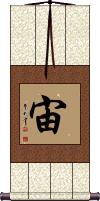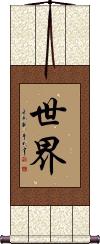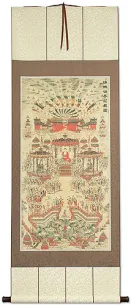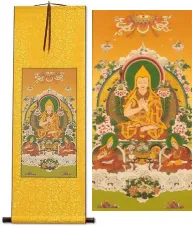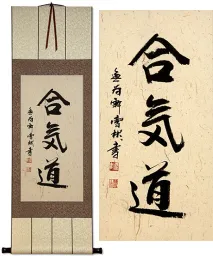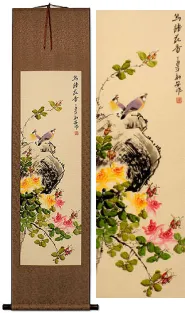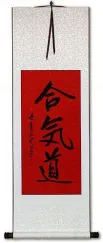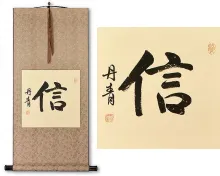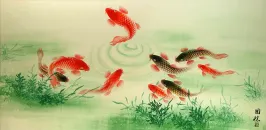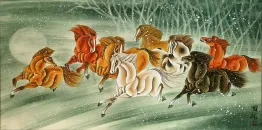Many custom options...
And formats...

Not what you want?
Try other similar-meaning words, fewer words, or just one word.
Universe Space in Chinese / Japanese...
Buy an Universe Space calligraphy wall scroll here!
Personalize your custom “Universe Space” project by clicking the button next to your favorite “Universe Space” title below...
Universe / Space
宙 means universe, cosmos, or outer space in Chinese, Japanese Kanji, and old Korean Hanja.
This can also mean air or midair depending on context.
In Korean, this can mean eternity in some contexts.
In Japanese, this can also be the female given name Haruka.
The Universe in Balance / Balanced Universe
宇宙平衡 is a proverb that is simply Universe Balanced (we might say “Balanced Universe” in English).
The first two characters mean the Universe. However, in some contexts, it can mean cosmic, cosmos, or outer space.
The second two characters mean balance or balanced (can also mean equilibrium).
Universe / Cosmos
宇宙 is a Chinese, Japanese Kanji, and old Korean Hanja word that means universe, cosmos, and space.
This can also be a given name, Hiroshi, in Japanese.
Sky / Void
虛空 means void, hollow, empty, space, sky, atmosphere, heaven, or ether.
虛空 is the Chinese and Japanese version of the Sanskrit word ākāśa (or akasa / akash) which, beyond the sky or space meaning can be the immaterial universe behind all phenomena in the Buddhist context.
The World
世界 is the Chinese, Japanese Kanji, and old Korean Hanja for the world.
Beyond the world, this can refer to society, the universe, space, a sphere, or a circle.
In Buddhism, this would mean the realm governed by one Buddha.
This in-stock artwork might be what you are looking for, and ships right away...
Gallery Price: $90.00
Your Price: $49.88
Starting at: $28.88
Starting at: $28.88
Starting at: $28.88
Gallery Price: $200.00
Your Price: $88.88
Gallery Price: $90.00
Your Price: $49.88
Gallery Price: $87.00
Your Price: $47.88
Gallery Price: $87.00
Your Price: $47.88
Gallery Price: $65.00
Your Price: $39.88
Gallery Price: $340.00
Your Price: $188.88
Not the results for Universe Space that you were looking for?
Below are some entries from our dictionary that may match your Universe Space search...
| Characters If shown, 2nd row is Simp. Chinese |
Pronunciation Romanization |
Simple Dictionary Definition |
世界 see styles |
shì jiè shi4 jie4 shih chieh sekai せかい |
More info & calligraphy: The World(1) the world; society; the universe; (2) sphere; circle; world; (can be adjective with の) (3) world-renowned; world-famous; (4) {Buddh} (original meaning) realm governed by one Buddha; space; (surname, female given name) Sekai Loka 世間; the finite world, the world, a world, which is of two kinds: (1) 衆生世界 that of the living, who are receiving their 正報 correct recompense or karma; (2) 器世界 that of the material, or that on which karma depends for expression. By the living is meant 有情 the sentient. |
宇宙 see styles |
yǔ zhòu yu3 zhou4 yü chou uchuu / uchu うちゅう |
More info & calligraphy: Universe / Cosmosuniverse; cosmos; space; (given name) Hiroshi universe |
虛空 虚空 see styles |
xū kōng xu1 kong1 hsü k`ung hsü kung kokū |
More info & calligraphy: Nothingness / Empty / Voidśūnya; empty, void, space; ākāśa, in the sense of space, or the ether; gagana, the sky, atmosphere, heaven; kha, space, sky, ether, 虛 is defined as that which is without shape or substantiality, 空 as that which has no resistance. The immaterial universe behind all phenomena. |
三界 see styles |
sān jiè san1 jie4 san chieh sangai さんがい |
(1) {Buddh} (See 欲界,色界,無色界) the three realms of existence; (2) (abbreviation) {Buddh} (See 三千大千世界) the whole universe (of a billion worlds) that Buddha enlightened; (3) {Buddh} (See 三世・さんぜ・1) past, present and future existences; (suffix) (4) far-off ...; distant ...; (surname) Mikai Trailokya or Triloka; the three realms; also 三有. It is the Buddhist metaphysical equivalent for the Brahmanic cosmological bhuvanatraya, or triple world of bhūr, bhuvaḥ, and svar, earth, atmosphere, and heaven. The Buddhist three are 欲, 色, and 無色界, i.e. world of sensuous desire, form, and formless world of pure spirit. (a) 欲界 Kāmadhātu is the realm of sensuous desire, of 婬 and 食 sex and food; it includes the six heavens of desire, the human world, and the hells. (b) 色界 Rūpadhātu is the realm of form, meaning 質礙 that which is substantial and resistant: it is above the lust-world and contains (so to speak) bodies, palaces, things, all mystic and wonderful一a semi-material conception like that in Revelation; it is represented in the 四禪天, or Brahmalokas. (c) 無色界 Arūpadhātu, or ārūpyadhātu, is the formless realm of pure spirit, where there are no bodies, places, things, at any rate none to which human terms would apply, but where the mind dwells in mystic contemplation; its extent is indefinable, but it is, conceived of in four stages, i,e. 四空處 the four "empty" regions, or regions of space in the immaterial world, which are 四無色 the four "formless" realms, or realms beyond form; being above the realm of form, their bounds cannot be defined. v. 倶舍論世間品. |
二如 see styles |
èr rú er4 ru2 erh ju ninyo |
There are various definitions of the two aspects of the 眞如 bhūtatathatā. (1) (a) 不變眞如 The changeless essence or substance, e.g. the sea; (b) 隨緣眞如 its conditioned or ever-changing forms, as in the phenomenal world, e.g. the waves. (2) (a) 離言眞如 The inexpressible absolute, only mentally conceivable; (6) 依言眞如 aspects of it expressible in words, its ideal reflex. (3) (a) 空眞如 The absolute as the void, e.g. as space, the sky, a clear mirror; (b) 不空眞如 the absolute in manifestation, or phenomenal, e. g. images in the mirror: the womb of the universe in which are all potentialities. (4) (a) 在纏眞如The Buddha-nature in bonds, i.e. all beings in suffering; (b) 出纏真如the Buddha-nature set free by the manifestation of the Buddha and bodhisattvas. (5) (a) 有垢眞如The Buddha-nature defiled, as in unenlightened man, etc., e.g. the water-lily with its roots in the mud; (b) 無垢眞如 the pure Buddha-nature, purifed or bright as the full moon. (6) 安立 and 非安立眞如 similar to the first definition given above. |
虛空住 虚空住 see styles |
xū kōng zhù xu1 kong1 zhu4 hsü k`ung chu hsü kung chu Kokū jū |
Ākāśapratiṣṭhita, abiding in space, the fifth son of Mahābhijña, a bodhisattva to the south of our universe. |
五種法身 五种法身 see styles |
wǔ zhǒng fǎ shēn wu3 zhong3 fa3 shen1 wu chung fa shen goshu hosshin |
The five kinds of a Buddha's dharmakāya. There are four groups. I. (1) 如如智法身 the spiritual body of bhūtatathatā-wisdom; (2) 功德法身 of all virtuous achievement; (3) 自法身 of incarnation in the world; (4) 變化法身 of unlimited powers of transformation; (5) 虛空法身 of unlimited space; the first and second are defined as saṃbhogakāya, the third and fourth as nirmāṇakāya, and the fifth as the dharmakāya, but all are included under dharmakāya as it possesses all the others. II. The esoteric cult uses the first four and adds as fifth 法界身 indicating the universe as pan-Buddha. III. Huayan gives (1) 法性生身 the body or person of Buddha born from the dharma-nature. (2) 功德生身 the dharmakāya evolved by Buddha virtue, or achievement; (3) 變化法身 the dharmakāya with unlimited powers of transformation; (4) 實相法身 the real dharmakāya; (5) 虛 空法身 the universal dharmakāya. IV. Hīnayāna defines them as 五分法身 q. v. |
十一切處 十一切处 see styles |
shí yī qiè chù shi2 yi1 qie4 chu4 shih i ch`ieh ch`u shih i chieh chu jū issai sho |
Ten universals, or modes of contemplating the universe from ten aspects, i.e. from the viewpoint of earth, water, fire, wind blue, yellow, red, white, space, or mind. For example, contemplated under the aspect of water, then the universe is regarded as in flux and change. Also called 十禪支, 十遍處定. It is one of the 三法. |
The following table may be helpful for those studying Chinese or Japanese...
| Title | Characters | Romaji (Romanized Japanese) | Various forms of Romanized Chinese | |
| Universe Space | 宙 | chuu / haruka chu / haruka | zhòu / zhou4 / zhou | chou |
| The Universe in Balance Balanced Universe | 宇宙平衡 | u chuu hei kou uchuuheikou u chu hei ko | yǔ zhòu píng héng yu3 zhou4 ping2 heng2 yu zhou ping heng yuzhoupingheng | yü chou p`ing heng yüchoupingheng yü chou ping heng |
| Universe Cosmos | 宇宙 | uchuu / uchu | yǔ zhòu / yu3 zhou4 / yu zhou / yuzhou | yü chou / yüchou |
| Sky Void | 虛空 虚空 | kokū | xū kōng / xu1 kong1 / xu kong / xukong | hsü k`ung / hsükung / hsü kung |
| The World | 世界 | sei kai / seikai | shì jiè / shi4 jie4 / shi jie / shijie | shih chieh / shihchieh |
| In some entries above you will see that characters have different versions above and below a line. In these cases, the characters above the line are Traditional Chinese, while the ones below are Simplified Chinese. | ||||
Successful Chinese Character and Japanese Kanji calligraphy searches within the last few hours...
